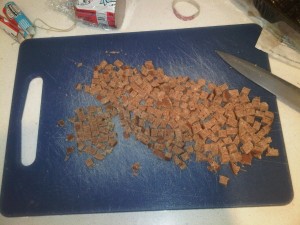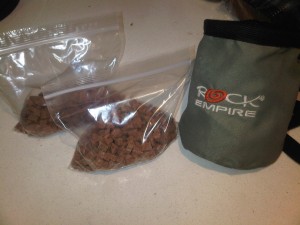This post is all about preparing for class to maximize the efficiency, effectiveness, and intensity of your training. As an instructor, it is clear to see which students come fully prepared for class, and in general, those that are well prepared do better both in class, and overall.
Since I am a dog trainer by profession, I may take preparation to a level that is beyond that of an average family dog owner, and I know there are people who are more disciplined than I am, but certainly everyone could make minor improvements in their preparation.
Prepare The Day Before Class
- Exercise, exercise, exercise the dog – not to the point of exhaustion, but so they can sleep well that night.
- Ensure the dog has a lot of uninterrupted sleep – having a house party that goes on till late at night will keep your dog from resting well.
- Avoid stressful events (i.e. grooming, vet exam, being taken to somewhere new).
- Avoid excessive feeding the day before so they are hungry on the day of training class.
- Make sure you have high value treats ready for class. I keep ample tubes of Rollover and Natural Balance around the house.
Prepare The Day of Class
- Prepare multiple types of treats, freshly cut, and separated into zip loc bags. All of them should be of fairly high value, but of course, some more than others. Currently I am bringing one bag of Turkey Rollover, and one bag of Salmon Rollover.
- Prepare all equipment needed for class. Clicker, target stick, mat, tug toy, treat pouch loaded with some treats, extra treats in ziploc bags, etc. The mat is very important (to be covered in the next blog post in this series)
- Avoid excessive exercise for the dog that day. Too much, and the dog will be too tired to work.
- I do not feed my dogs any food until class starts. That may mean the first food of the day is in the evening. They’ll live.
- I block off the two hours preceding a class, so that I can relax and not feel rushed.
If we are to demand 100% of our dog’s attention during class, they deserve 100% of ours.
Prepare for Leaving Home for Class:
- At home – walk the dog to allow them to fully eliminate and burn off a little energy before leaving. My dogs are older, so they don’t need to burn off steam prior to class.
- Arrival time: I aim to arrive at the front door of the school 10 minutes before class. Too early, and the dog can get impatient waiting for class to start. Too late, and you won’t have enough time to walk the grounds to let the dog eliminate one more time. I would err on the side of arriving early vs. late.
- Training starts as soon as I get to the car. Going into the car is a HUGE reinforcer, so the dog must hold a sit before being cued to hop in the car. My clicker is on me, my pouch is on me, and I am ready to click/treat from this point moving forward.
- During the drive there, I reinforce calm behaviors. Every time the dog lays down and relaxes, I click, then treat.
- When we arrive at the school, training continues. The dog must offer a sit and hold sit as I open the door – and release the dog. At this point, the dog gets 100% of my focus. Phone is off, no idle conversations with anyone – I am here to pay attention to my dog.
This is what I do to prepare so that both Petey and I arrive to school focused, energized, and ready to work. The opposite looks like:
- Coming to school late – the dog is anxious because the handler is anxious about being late, and often is rushed from the car to the school without having a chance to eliminate. Dogs have had accidents minutes after arriving to school because of this, which further stresses both the dog and handler. The handler also misses out on instruction so the next 10 minutes of class is also a writeoff.
- Not having treats cut and prepared – the dog is left in limbo while the handler has to spend 5 minutes cutting treats – that is 10% of the class wasted, and the dog’s mind is allowed to wander.
- Not having enough treats – the dog is left in limbo as the handler has to somehow get some treats (take from the school, or buy from the retail store in front). The dog gets to practice disconnecting from the handler, again.
- Equipment buried deep in a bag, not readily available. The dog’s good behavior during the leadup to class (sitting, eye contact, waiting at a boundary, etc.) go unreinforced, so the dog just pulls around and sniffs aimlessly entering class. Training MUST begin the minute the dog is released from the car and the dog should not be allowed to do his own thing until after class ends.
- Not exercising the dog enough (in particular, the day before) – the dog is hyperactive and can’t focus in class.
What’s the Point of All This?
The point of all this is to make all the details and particulars around getting to and functioning in class easy, so that 100% of your attention is available for the dog. Clicker training is hard enough as it is! I often tell students in my classes – If we are to demand 100% of our dog’s attention during class, they deserve 100% of ours. With that foundation in place, we can eliminate opportunities for a dog to be left in limbo, drift off, get distracted, and lose focus. In the next post in this series, I’ll talk about how I work inside the classroom to maintain a very high level of intensity and focus from the dog.


